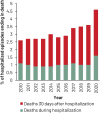The Incidence of Skin and Soft Tissue Infections in the United States and Associated Healthcare Utilization Between 2010 and 2020
- PMID: 38835497
- PMCID: PMC11146672
- DOI: 10.1093/ofid/ofae267
The Incidence of Skin and Soft Tissue Infections in the United States and Associated Healthcare Utilization Between 2010 and 2020
Abstract
Background: The number of patients with skin and soft tissue infections (SSTIs) in the United States appeared to be increasing well into the 21st century. However, no recent data have confirmed this trend.
Methods: This retrospective, observational cohort study used claims data over 11 years (2010-2020) from Optum's de-identified Clinformatics Data Mart Database. SSTI episodes, complications, and comorbidities were identified using International Classification of Diseases codes. Annual SSTI incidence rates, proportions of recurrent SSTI, SSTI-associated deaths, and total costs were estimated.
Results: During the study period, 5.4 million patients experienced 9.1 million SSTI episodes, with an incidence of 77.5 (95% confidence interval, 77.4-77.5) per 1000 person-years of observation (PYO). Annual incidence did not change significantly over time. Overall incidence (per 1000 PYO) of SSTI episodes in patients without comorbidities was 32.1 (highest incidence was for previous SSTI [113.5]) versus much higher rates if comorbidities were present. Incidence rates (per 1000 PYO) of chronic ulcers increased over time from 11.3 to 18.2 (P < .0001) and complicated disease from 3.5 to 6.3 (P < .0001). Deaths occurring within 30 days post-SSTI hospitalization rose from 2.6% to 4.6% in 2020. Recurrences occurred in 26.3% of index cases. The mean cost of an SSTI episode was US$3334 (median US$190) and was highest for surgical site infections and chronic ulcers.
Conclusions: The epidemiology of SSTI in the United States is changing and the disease burden is increasing despite stabilization in overall incidence. These data can inform identification of priority populations who could benefit from targeted interventions.
Keywords: chronic ulcer; epidemiology; healthcare costs; incidence; skin and soft tissue infections.
© GSK 2024. Published by Oxford University Press on behalf of Infectious Diseases Society of America.
Conflict of interest statement
Potential conflicts of interest. E. A., M. P., F. B., V. V., and M. S. are employed by and hold financial equities in GSK. D. D. is employed by GSK. M. C. was employed by GSK at the time of the study. These authors declare no other financial and non-financial relationships and activities.
Figures




References
-
- Pallin DJ, Egan DJ, Pelletier AJ, Espinola JA, Hooper DC, Camargo CA Jr. Increased US emergency department visits for skin and soft tissue infections, and changes in antibiotic choices, during the emergence of community-associated methicillin-resistant Staphylococcus aureus. Ann Emerg Med 2008; 51:291–8. - PubMed
-
- Hersh AL, Chambers HF, Maselli JH, Gonzales R. National trends in ambulatory visits and antibiotic prescribing for skin and soft-tissue infections. Arch Intern Med 2008; 168:1585–91. - PubMed

